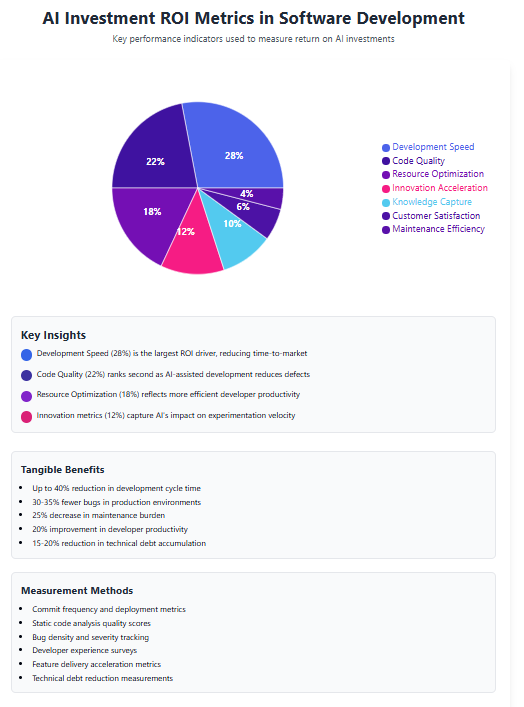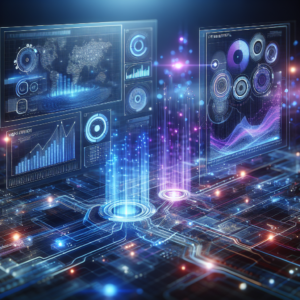Artificial intelligence isn’t just reshaping how developers write code—it’s transforming the entire software development lifecycle. From strategic planning and product management to quality assurance and deployment, AI is enabling a smarter, faster, and more collaborative approach to building software. It’s not limited to automation; it’s about revolutionizing how teams work and decisions are made.
For enterprise leaders, this means more than increased efficiency. It’s an opportunity to leverage predictive analytics, automate testing, and even empower non-technical teams through low-code platforms—all while navigating challenges like integration and risk management. The result? A competitive edge in delivering faster, more reliable software at scale.
Let’s explore how AI for software development is driving this transformation and what it means for your organization’s future.
Key Takeaways
- Comprehensive Development Transformation: AI is revolutionizing the entire software development lifecycle, from initial planning and design through deployment and maintenance, not just coding tasks.
- Strategic Decision Enhancement: AI tools are improving product management and strategic decision-making by providing data-driven insights and predictive analytics for better project outcomes.
- Automated Quality Assurance: AI-powered testing and debugging capabilities significantly reduce development time while improving code quality and reliability through continuous automated testing.
- Development Democratization: Low-code and AI-assisted platforms are enabling non-developers to participate in software creation, expanding development capabilities across organizations.
- Efficiency Optimization: AI-powered code generation and completion tools can increase developer productivity by up to 40% while reducing common coding errors.
- Integration Considerations: Successful AI implementation requires careful planning for integration with existing development workflows and legacy systems.
- Risk Management: Organizations must address potential challenges including data security, AI reliability, and maintaining human oversight in automated processes.
- Organizational Impact: Adopting AI in software development necessitates changes in team structure, skill requirements, and development methodologies.
- ROI Metrics: Measuring success through key performance indicators such as development speed, code quality, and resource utilization is crucial for justifying AI investments.
AI for software development has emerged as a transformative force in the enterprise technology landscape. As organizations seek to accelerate innovation while maintaining quality, artificial intelligence offers powerful capabilities that extend throughout the development lifecycle. This article explores how AI is reshaping software engineering practices, empowering teams, and creating competitive advantages for forward-thinking enterprises.
Leveraging AI for Software Development: Transforming the Development Lifecycle

The integration of AI for software development represents a fundamental shift in how organizations conceptualize and execute their development processes. Unlike traditional approaches that rely heavily on manual coding and human decision-making, AI-enhanced development introduces intelligent automation and data-driven insights across the entire software creation journey.
Modern AI systems analyze vast repositories of code, learning patterns and best practices from millions of development projects. This collective intelligence enables AI to assist developers with everything from architecture planning to implementation details, creating a multiplier effect on team productivity.
The most advanced AI development platforms now offer capabilities that were unimaginable just a few years ago: generating functional code from natural language descriptions, automatically refactoring legacy systems, identifying potential security vulnerabilities before deployment, and even predicting future maintenance needs based on code structure analysis.
For enterprise organizations, this transformation means faster time-to-market, reduced development costs, and the ability to create more sophisticated software solutions with existing teams. Companies implementing AI-driven development report up to 40% reduction in development time for certain projects, allowing them to respond more quickly to market changes and customer needs.
As AI capabilities continue to advance, the boundary between human and machine contributions to software development is becoming increasingly fluid, creating new opportunities for innovation and efficiency across the enterprise technology ecosystem.
AI’s Impact on the Software Development Lifecycle
The influence of artificial intelligence in software engineering extends far beyond just writing code. AI technologies are now integrated throughout every phase of the software development lifecycle (SDLC), creating a more connected and intelligent process from conception to retirement.
In the planning phase, AI analyzes historical project data to provide more accurate time and resource estimates. Natural language processing helps translate business requirements into technical specifications, reducing misunderstandings between stakeholders and development teams.
During design, AI suggests architectural patterns based on project requirements and constraints. It can evaluate different design approaches against performance metrics, security considerations, and maintainability factors to recommend optimal solutions.
The implementation phase benefits from AI-powered code completion, bug prediction, and automated testing generation. These tools act as an intelligent pair programmer, suggesting improvements and catching potential issues in real-time.
Testing becomes more comprehensive with AI that generates test cases based on code analysis, prioritizes tests based on risk assessment, and performs visual regression testing on user interfaces. This results in higher quality software with fewer escaped defects.
In deployment and operations, AI monitors application performance, predicts potential failures before they occur, and automatically scales resources based on usage patterns. This creates more resilient systems that require less manual intervention.
A major financial services company implemented AI across their SDLC and reported a 35% reduction in production incidents while increasing feature delivery by 28% – demonstrating how AI creates value throughout the entire development process.
Enhancing Strategic Decision-Making with AI
Beyond technical improvements, AI-powered software development tools are revolutionizing how organizations make strategic decisions about their technology investments. By analyzing vast amounts of development data, AI provides insights that help leaders allocate resources more effectively and prioritize initiatives with the highest business impact.
AI systems can now evaluate proposed features against user behavior data, market trends, and competitive analysis to predict potential ROI before development begins. This capability helps product managers focus on building what users actually need rather than what they think users want.
For technology executives, AI offers unprecedented visibility into development operations. Advanced analytics dashboards highlight bottlenecks in the development process, identify teams that may need additional support, and forecast delivery timelines with increasing accuracy.
Risk assessment becomes more sophisticated with AI that evaluates technical debt across the codebase, identifies security vulnerabilities, and predicts maintenance costs based on code quality metrics. These insights allow leaders to make informed decisions about when to refactor existing systems versus build new solutions.
Enterprise AI automation services are particularly valuable for strategic roadmap planning, as they can simulate different development scenarios and their likely outcomes. This allows organizations to test various approaches virtually before committing real resources.
One global retailer used AI-driven analytics to reprioritize their development roadmap, resulting in a 22% increase in customer engagement with their digital platforms and a corresponding 18% growth in online revenue, demonstrating the strategic value of AI-informed decision making.
Automating Quality Assurance through AI
Quality assurance has traditionally been a time-intensive phase of software development, often creating bottlenecks that delay releases. AI for software development is transforming this landscape through intelligent automation that makes testing more thorough, efficient, and continuous.
Modern AI testing platforms can automatically generate test cases based on code changes, focusing testing efforts on the areas most likely to contain defects. This targeted approach ensures comprehensive coverage while eliminating redundant tests that waste computing resources.
Visual testing has been revolutionized by AI that can detect subtle UI inconsistencies across different devices and browsers – issues that would be extremely time-consuming for human testers to identify. These systems learn what constitutes a visual regression versus an intentional design change, reducing false positives.
Performance testing benefits from AI that can simulate realistic user loads and identify performance bottlenecks before they impact real users. These systems continuously monitor application metrics, automatically adjusting test parameters to find breaking points and optimization opportunities.
Security testing has become more proactive with AI that scans code for vulnerabilities during development rather than after completion. By integrating with development environments, these tools provide immediate feedback to developers about potential security issues, allowing them to fix problems before code is committed.
A healthcare technology company implemented AI-driven testing automation and reduced its QA cycle from two weeks to three days while increasing test coverage by 40%. This acceleration allowed them to release updates more frequently while maintaining strict compliance with regulatory requirements.
Continuous Testing Integration
The most advanced AI testing frameworks now integrate seamlessly with continuous integration/continuous deployment (CI/CD) pipelines, creating truly automated quality gates. These systems make intelligent decisions about whether code changes should proceed to production based on comprehensive test results and risk analysis.
By combining automated code generation with automated testing, organizations can create a virtuous cycle where AI helps produce better code that passes more rigorous testing with less human intervention. This approach shifts quality assurance from a separate phase to an integrated aspect of the entire development process.
Democratizing Development with AI Tools
One of the most significant impacts of AI for software development is the democratization of coding capabilities across organizations. AI-powered development platforms are making software creation accessible to a much wider audience, including business analysts, domain experts, and other technical professionals who lack traditional programming backgrounds.
Low-code platforms enhanced with AI capabilities allow users to create applications through visual interfaces while AI handles the underlying code generation. These systems interpret natural language descriptions of desired functionality and translate them into working software components, bridging the gap between business requirements and technical implementation.
For business users, this means the ability to create custom applications that address specific operational needs without waiting for IT department resources. Solutions that previously might have taken months to develop can now be created in days or weeks by the very people who understand the business problems best.
Even for professional developers, AI democratization tools provide significant advantages by handling routine coding tasks and allowing them to focus on more complex and creative aspects of software development. This shift enables organizations to make better use of their specialized technical talent.
Low-code vs AI automation represents an evolving landscape where these technologies increasingly complement each other, with AI making low-code platforms more powerful and intuitive while low-code interfaces make AI capabilities more accessible.
A manufacturing company implemented AI-powered low-code tools that enabled production managers to create their own quality control applications. This initiative resulted in 12 new specialized applications deployed in a single quarter – more than the IT department had previously been able to deliver in a full year.
Citizen Developer Empowerment
The rise of AI-assisted development is creating a new category of “citizen developers” – employees who can create applications to solve business problems without formal software engineering training. Organizations that effectively support these citizen developers with appropriate governance and AI tools are seeing dramatic increases in innovation and process automation.
This democratization trend is particularly valuable for addressing the “long tail” of business application needs – specialized use cases that would never rise to the priority level required for formal IT development but still offer significant operational improvements when addressed.
Optimizing Efficiency in Development Processes

The integration of machine learning for code generation has dramatically improved developer productivity by automating routine coding tasks and providing intelligent assistance during the development process. These AI capabilities act as a force multiplier for development teams, allowing them to produce more code with fewer errors in less time.
Advanced code completion tools now go far beyond simple syntax suggestions, offering entire function implementations based on the developer’s intent. By analyzing the surrounding code context and understanding common programming patterns, these systems can predict what the developer is trying to accomplish and generate appropriate code snippets.
Refactoring assistance has become more intelligent with AI that can identify code smells and suggest structural improvements. These tools analyze code quality metrics and recommend changes that improve maintainability without changing functionality, helping teams manage technical debt more effectively.
Documentation generation has been transformed by AI, which can analyze code and produce human-readable explanations of its purpose and behavior. This capability helps maintain up-to-date documentation, which is traditionally one of the most neglected aspects of software development.
Code review processes benefit from AI, which automatically checks for common issues before human reviewers get involved. These systems flag potential bugs, security vulnerabilities, and performance problems, allowing human reviewers to focus on higher-level architectural concerns rather than catching basic mistakes.
A technology consulting firm implemented AI coding assistants across their development teams and measured a 27% increase in feature delivery velocity while simultaneously reducing defect rates by 23% – demonstrating how AI can improve both speed and quality simultaneously.
Developer Experience Enhancement
Beyond pure productivity metrics, AI tools are improving the overall developer experience by reducing frustration and cognitive load. By handling repetitive tasks and providing contextual assistance, these systems allow developers to maintain flow state and focus on the creative aspects of software creation.
The most effective organizations are creating integrated development environments where AI assistants work alongside human developers, each contributing their unique strengths to the development process. This collaborative approach represents the future of software engineering.
Integration of AI with Existing Workflows
Successfully integrating AI tools into existing software development workflows requires thoughtful planning and implementation. Organizations must balance the potential benefits of AI with the practical realities of their current development processes, team structures, and technology stacks.
Legacy systems present particular challenges for AI integration. Many enterprises operate complex software environments built over decades, often with limited documentation and using outdated technologies. AI tools must be able to understand and work with these existing codebases rather than requiring complete rewrites.
Incremental adoption strategies have proven most successful for organizations introducing AI into their development processes. Starting with specific, high-value use cases allows teams to gain experience with AI tools and demonstrate concrete benefits before expanding to broader implementation.
Integration with existing DevOps pipelines is critical for AI adoption. The most effective implementations connect AI capabilities with source control systems, continuous integration servers, and deployment automation to create a seamless workflow where AI becomes an invisible part of the development process.
Implementing AI process automation requires careful consideration of how AI tools will interact with human developers. Clear guidelines about when to rely on AI suggestions versus human judgment help teams use these tools effectively without becoming overly dependent on them.
A financial technology company implemented a phased approach to AI integration, starting with code completion tools for their front-end teams. After demonstrating a 15% productivity improvement, they expanded to back-end development and eventually integrated AI throughout their entire development pipeline, achieving a 30% overall reduction in development time.
Change Management Considerations
The human aspects of AI integration are often more challenging than the technical implementation. Developers may initially resist AI tools due to concerns about job security, quality control, or changes to familiar workflows. Effective change management strategies address these concerns through education, transparent communication, and gradual introduction of new capabilities.
Organizations that position AI as an enhancement to developer capabilities rather than a replacement for human creativity tend to see higher adoption rates and more positive outcomes. This framing helps teams embrace AI as a valuable collaborator rather than viewing it as a threat.
Addressing Risks and Challenges of AI Adoption
While AI for software development offers tremendous benefits, it also introduces new risks and challenges that organizations must address proactively. Understanding these potential pitfalls is essential for the successful implementation and responsible use of AI development tools.
Code quality concerns arise when developers rely too heavily on AI-generated code without proper review. AI systems may produce functional but suboptimal solutions that introduce technical debt or performance issues over time. Organizations need clear guidelines for when and how to use AI-generated code in production systems.
Security vulnerabilities can be inadvertently introduced when AI tools generate code based on patterns learned from public repositories that may contain security flaws. Regular security scanning and review processes must be maintained even when using AI assistance.
Intellectual property questions emerge when AI generates code based on training data that may include proprietary or licensed code. Organizations must understand the legal implications of using AI-generated code and ensure compliance with licensing requirements.
Dependency risks increase as development teams integrate AI tools into their workflows. If these tools become unavailable or change their functionality, development processes could be disrupted. Organizations should consider contingency plans for AI tool outages.
A technology company discovered that its AI code generator had introduced subtle performance issues across multiple applications. They implemented a hybrid review process where AI-generated code underwent both automated performance testing and targeted human review, reducing performance-related incidents by 65%.
Maintaining Human Oversight
The most successful AI implementations maintain appropriate human oversight throughout the development process. Rather than blindly accepting AI suggestions, effective teams use AI as a starting point that accelerates development while still applying human judgment to final decisions.
Creating clear accountability frameworks helps organizations balance automation with responsibility. These frameworks define who is ultimately responsible for code quality, security, and performance, even when AI systems are involved in generating or reviewing that code.
Organizational Impact of AI-Driven Development
The adoption of AI-powered software development tools is catalyzing significant changes in how technology organizations structure their teams, define roles, and develop talent. These organizational transformations are as important as the technical changes needed to realize the full potential of AI in software development.
Team structures are evolving to incorporate new roles focused on AI integration and oversight. Many organizations are creating positions such as AI Operations Engineers who specialize in maintaining and optimizing AI development tools, ensuring they remain aligned with organizational needs and values.
Skill requirements for developers are shifting to emphasize collaboration with AI systems. The most valuable developers are increasingly those who can effectively prompt, direct, and evaluate AI tools rather than those who can write the most code manually. This represents a fundamental change in how developer productivity is measured and valued.
Training programs are being redesigned to help existing development teams adapt to AI-enhanced workflows. These programs focus not only on technical skills for using AI tools but also on critical thinking abilities needed to evaluate AI outputs and recognize when human intervention is required.
Career paths are diversifying as AI creates new specialization opportunities. Some developers are focusing on becoming AI integration experts, while others are moving toward higher-level architecture and design roles where human creativity and business understanding remain essential.
A global technology consulting firm reorganized its development teams around AI capabilities, creating specialized pods that combine AI specialists with domain experts. This structure increased their delivery capacity by 40% while maintaining the same headcount, allowing them to take on more client projects.
Cultural Transformation
Beyond structural changes, AI for software development is driving cultural transformation within technology organizations. Teams are redefining what constitutes valuable work, moving away from measuring output in lines of code toward metrics that capture business impact and problem-solving effectiveness.
The most successful organizations are fostering cultures of continuous learning where developers are encouraged to experiment with AI tools and share their discoveries. This collaborative approach accelerates the adoption of best practices and helps teams stay current with rapidly evolving AI capabilities.
Measuring ROI in AI-Enabled Software Development

Quantifying the return on investment for AI for software development initiatives requires a multidimensional approach that captures both immediate productivity gains and longer-term strategic benefits. Organizations need comprehensive measurement frameworks to accurately assess the value of their AI investments.
Development velocity metrics provide the most visible indicators of AI impact. Teams typically measure increases in feature delivery rates, reductions in time-to-market, and acceleration of specific development activities like testing or code review. These metrics directly translate to business value through faster innovation cycles.
Quality improvements represent another critical dimension of ROI. Organizations track reductions in defect rates, security vulnerabilities, and production incidents attributable to AI-assisted development. These improvements reduce maintenance costs and enhance customer satisfaction.
Resource utilization becomes more efficient with AI assistance. Companies measure how AI allows them to deliver more functionality with existing teams or reduce the specialized expertise required for certain development tasks. This efficiency translates to direct cost savings or increased output capacity.
Custom AI integrations often deliver the highest ROI when they address specific organizational pain points rather than implementing generic AI capabilities. Targeted solutions that solve well-defined problems typically show a clearer return on investment.
An enterprise software company implemented AI code generation tools and measured their impact across multiple dimensions. They documented a 32% increase in feature delivery, a 28% reduction in critical bugs, and a 45% decrease in time spent on code reviews, creating an estimated annual value of $4.2 million against an investment of $850,000.
Long-Term Value Assessment
Beyond immediate operational improvements, organizations should evaluate the strategic value of AI development capabilities. This includes measuring increased business agility, the ability to respond to market changes, and the capacity to innovate in ways that weren’t previously possible with traditional development approaches.
The most sophisticated ROI models also account for talent advantages, as organizations with advanced AI development capabilities often become more attractive to top technical talent. This recruitment and retention benefit can be quantified through reduced hiring costs and increased team stability.
Best Practices for AI Implementation in Software Development
Successfully implementing AI for software development requires a strategic approach that balances technical considerations with organizational readiness. Organizations that follow these best practices are more likely to realize substantial benefits from their AI investments.
Start with clear objectives rather than implementing AI for its own sake. The most successful organizations identify specific development challenges or opportunities where AI can create measurable value, then select tools and approaches aligned with those objectives.
Implement in phases with defined success criteria for each stage. This incremental approach allows teams to gain experience with AI tools, demonstrate value, and refine their implementation strategy before expanding to broader use cases.
Invest in developer education to ensure teams understand both the capabilities and limitations of AI development tools. This knowledge helps developers use AI effectively while maintaining appropriate human oversight and judgment.
Establish governance frameworks that define how AI-generated code will be reviewed, tested, and approved before production deployment. These frameworks should balance the efficiency benefits of AI with necessary quality and security controls.
AI automation for developers works best when integrated into existing development environments and workflows rather than requiring teams to adopt entirely new tools or processes. This integration minimizes disruption while maximizing adoption.
A healthcare software company created a center of excellence for AI development that established standards, provided training, and supported teams implementing AI tools. This structured approach resulted in 85% developer adoption within six months and a 35% overall increase in development productivity.
Ethical Considerations
Beyond technical implementation, organizations must address ethical considerations in their AI development practices. This includes ensuring that AI systems don’t perpetuate biases, maintaining transparency about when and how AI is used in development, and establishing clear accountability for AI-assisted work.
Leading organizations are creating ethical guidelines specifically for AI in software development, addressing questions about appropriate use cases, required human oversight, and situations where AI assistance should be limited or avoided entirely.
Future-Proofing Organizations with AI in Software Development
As artificial intelligence in software engineering continues to evolve rapidly, forward-thinking organizations are implementing strategies to remain adaptable and competitive in this changing landscape. Future-proofing requires both technical flexibility and organizational agility.
Continuous learning programs help development teams stay current with emerging AI capabilities and best practices. Organizations that invest in ongoing education create a culture of innovation where teams actively explore new ways to leverage AI in their development processes.
Flexible architecture approaches enable organizations to integrate new AI tools and capabilities as they emerge. Modular systems with well-defined interfaces allow teams to replace or enhance specific components without disrupting entire development ecosystems.
Strategic partnerships with AI technology providers give organizations early access to new capabilities and influence over future development directions. These relationships help companies anticipate changes in the AI landscape and prepare for emerging opportunities.
Talent strategies focused on adaptability rather than specific tool expertise help organizations build teams that can evolve with changing technology. Hiring for learning capacity and problem-solving abilities creates more resilient development organizations than focusing narrowly on current technical skills.
A global financial institution established an AI innovation lab within its development organization, dedicating 10% of technical resources to exploring emerging AI capabilities. This investment has allowed them to identify and implement new AI development approaches 6-12 months ahead of competitors, creating a significant competitive advantage.
Emerging Trends
Several emerging trends will shape the future of AI in software development. Autonomous systems that can maintain and evolve themselves with minimal human intervention represent the next frontier. These systems will combine machine learning for code generation with advanced testing and deployment capabilities to create self-improving software.
Specialized AI for specific development domains is another important trend. Rather than general-purpose coding assistants, we’re seeing the emergence of AI systems with deep expertise in particular languages, frameworks, or application types. These specialized tools offer more sophisticated assistance for their target domains.
The integration of AI throughout the entire software lifecycle will continue to deepen, with intelligent systems providing guidance from initial concept through retirement. This end-to-end intelligence will create more cohesive development experiences and help organizations manage software assets more effectively throughout their lifecycle.
Conclusion: The Transformative Impact of AI in Software Development
The integration of AI for software development represents a fundamental shift in how organizations create, maintain, and evolve their software assets. By enhancing human capabilities throughout the development lifecycle, AI is enabling unprecedented levels of productivity, quality, and innovation.
Organizations that successfully implement AI in their development processes gain significant competitive advantages: faster time-to-market, higher quality software, more efficient resource utilization, and the ability to tackle more complex challenges. These benefits translate directly to business value through improved customer experiences, operational efficiency, and market responsiveness.
As AI capabilities continue to advance, the relationship between human developers and intelligent systems will evolve toward true collaboration, with each contributing their unique strengths to the development process. This partnership approach represents the future of software engineering.
For technology leaders, the message is clear: AI for software development is not merely a productivity tool but a strategic capability that will increasingly differentiate successful organizations from their competitors. Investing in AI development capabilities today creates the foundation for sustained innovation and competitive advantage in an increasingly digital business landscape.
Ready to transform your software development processes with AI? Explore our enterprise AI automation services to discover how your organization can leverage artificial intelligence to accelerate innovation while improving quality and efficiency.
References
explodingtopics.com
hai.stanford.edu
mckinsey.com
nu.edu
teneo.ai
Frequently Asked Questions
AI has become the co-pilot for modern developers, transforming how code gets written. From generating boilerplate code to debugging in real-time, AI tools like GitHub Copilot and Amazon CodeWhisperer reduce repetitive tasks. Key advantages include faster prototyping, error reduction, and the ability to focus on complex problem-solving. A Stanford study shows AI-assisted coding can improve developer productivity by up to 55%, while McKinsey reports 92% of executives plan to increase AI investment in the next three years.
The landscape includes specialized tools for different development stages. GitHub Copilot leads in code generation, while Tabnine excels at personalized code completions. For testing, tools like Applitools leverage AI for visual validation. Enterprise teams often combine multiple tools, with 83% of companies prioritizing AI integration in their tech stacks according to Exploding Topics. Small businesses show similar momentum, with 89% already using AI-driven automation for tasks like documentation and quality assurance.
AI acts as a force multiplier across the development lifecycle. During planning, predictive analytics helps scope projects accurately. Coding assistants reduce syntax errors, while AI-powered testing tools identify edge cases humans might miss. Maintenance becomes proactive through anomaly detection systems. Netflix’s $1 billion annual revenue from personalized recommendations demonstrates how AI-driven development can create business value. CompTIA data shows 55% of companies actively use AI in development, with another 45% exploring implementations.
Specialized AI programming assistants have evolved beyond simple autocomplete. Systems like DeepCode analyze patterns across millions of repositories to suggest optimizations, while tools like Kite offer documentation intelligence. The market responds to growing demand, projected to grow 38% in 2025 according to Teneo.Ai. These systems don’t replace developers but augment capabilities, particularly in code review and technical debt management.
Any Other Questions?
That wraps up the most popular questions we get, but fire away with any others!
Contact us to discuss your next development project!
FAQ References
https://explodingtopics.com/blog/ai-statistics
https://hai.stanford.edu/ai-index/2025-ai-index-report
https://www.mckinsey.com/capabilities/mckinsey-digital/our-insights/superagency-in-the-workplace-empowering-people-to-unlock-ais-full-potential-at-work
https://www.nu.edu/blog/ai-statistics-trends/
https://www.teneo.ai/blog/ai-ascendancy-unveiling-top-ai-statistics-and-trends-for-2025
Related Videos
How AI Agents can 10X your Income
YouTube Sucks for New AI Automation Agencies (Avoid This)
Make $0-$100K with an AI automation agent…
287 days of running an AI Agency – my honest thoughts
Build a $100K AI Automation Agent: The Ultimate Side Hustle Guide


